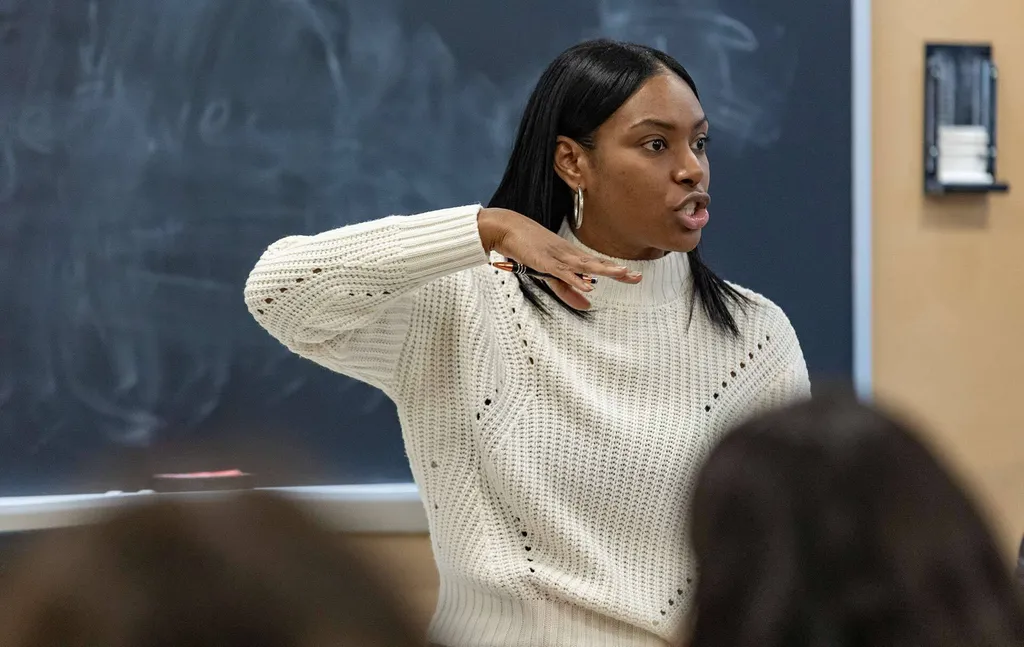- April 04, 2024
- By Maggie Haslam
It’s said that the only thing scarier than death is public speaking. At first glance, it looked like the students standing at the front of a classroom in Knight Hall on a recent Tuesday evening were facing either an audience or the Angel of Death. Palming their notecards, the slightly ashen group began their presentation with a bemusing (and slightly grisly) anecdote about a Tesla and a mannequin baby.
The audience laughed and the tension dissolved as they launched into a convincing argument about the perils of self-driving cars. Five minutes later, they hadn’t died—but they certainly slayed.
“Self-presentation in the Age of YouTube,” a public speaking class offered in the Phillip Merrill College of Journalism, is designed to prepare students for a lifetime of talking to people, from giving thesis presentations and keynote speeches to recording TikTok how-tos to having one-on-ones with the boss. Through a series of exercises, students learn to eliminate the flailing hands, pacing and litany of “ums” that plague so many who step up to the podium—and build a toolbox of techniques to quell anxiety and deliver their message with confidence.
“There’s so much anxiety with just knowing you’re going to have to speak in front of an audience,” said lecturer Amber Moore, who has taught the class since 2019. “People can’t get their nerves under control, and it’s like a spiral. But there are a lot of skills and techniques that can help.”

The course, which is open to all undergraduates, walks students through six assignments across the semester, including a persuasive speech, an introductory presentation and an informative YouTube video. As the course progresses, their presentation times—and the list of skills they must demonstrate—increases.
“I still get nervous, but I’ve seen a big improvement,” said information sciences major Daniel Hu ‘25. “I recently went back and watched a recorded presentation from another class I took and I’ve made a lot of progress.”
During the group presentation exercise, students practiced delivering “attention grabbers”—the anecdotes, visuals or statements that captivate an audience early—and honing paralinguistic skills, like volume, cadence and pitch (high for humor, low to emphasize serious matter). Extra points were given for employing one of several techniques learned the previous week, such as putting stress on a word or phrase for emphasis, or “substituting,” where a nonverbal gesture replaces a verbal message.
The COVID pandemic and the rise of electronic communication and social media, said Moore, has resulted in people communicating in-person less and less—and thus are losing their grasp on the finer points of the art of speaking. It’s a skill, she said, that is essential to a student’s day-to-day interactions, and can manifest in surprising places: A wrestler admitted to taking Moore’s class because his mother commented that his post-match interviews were horrendous.
“Public speaking is a universal skill, regardless of your discipline; sooner or later, everyone will have to do it,” she said.
Throughout the course, Moore (who was a television news reporter for 12 years) teaches students how to infuse creativity, humor, and flow into their delivery. She helps them take problems—like a need to move—and turn them into something they can use to add emphasis to what they’re saying. It’s a lot to think about, which is why students often bomb early on. But for Moore, the lesson isn’t about achieving perfection, but incremental progress each time her students get up in front of an audience. When one was discouraged after stumbling over her words, Moore reminded her that she didn’t stop or apologize—but gathered herself up and jumped back in.
“I tell them on day one that public speaking takes time,” said Moore. “I've been there and I can show them how to work through the anxiety. It is my greatest thrill to watch them gain those skills and confidence.”
Can’t “take this class”? Fear not—Moore has a few tips to help you nail your next speaking engagement:
Be yourself: The more comfortable you are in front of people, says Moore, the more confident you are—and that usually reflects in your presentation. “I find when you're being yourself, your personality shines through, and that resonates with the audience.”
Use (appropriate) humor: “It disarms the audience and allows them to sit back and listen versus feeling like they're being lectured,” says Moore.
Get grounded: Overusing gestures, shifting too much and making other distracting movements can take away from your message, said Moore. “It’s not something we think about until we see it,” she said. Instead, practice using your hands as nonverbal tools that back up your words.
Envision yourself doing well: Public speaking is skill as well as a psych-out, said Moore. “Remind yourself after each practice or presentation one or two things you did well and then visualize doing it again,” she said. “See yourself being successful, because you’ve already had some level of success.”
When all else fails, write it down: Trouble with eye contact? Forget to come up for air? Insert reminders for yourself in big letters throughout your notes. “Don’t be afraid to write ‘PAUSE’ in places for emphasis or ‘SLOW DOWN’ if you have a tendency to talk fast,” she said.
“Self-Preservation in the Age of YouTube” (JOUR130)
Satisfies: General education requirement in Fundamental Studies- Oral Communication
Next time you can take it: Summer 2024
A fun fact you’ll learn: Any speech should offer a quick preview at the beginning to let the audience know what they will learn. (“Before I hope in the car with you, let me know where we’re going,” says Moore.”)
Summary: The course offers tips and techniques to confidently conquer your fear of public speaking and get your message across.
